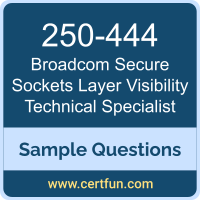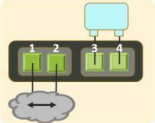 Getting knowledge of the Broadcom 250-444 exam structure and question format is vital in preparing for the Symantec Secure Sockets Layer Visibility 5.0 Technical Specialist certification exam. Our Broadcom Secure Sockets Layer Visibility Technical Specialist sample questions offer you information regarding the question types and level of difficulty you will face in the real exam. The benefit of using these Broadcom 250-444 sample questions is that you will get to check your preparation level or enhance your knowledge by learning the unknown questions. You will also get a clear idea of the exam environment and exam pattern you will face in the actual exam with the Symantec Secure Sockets Layer Visibility 5.0 Technical Specialist Sample Practice Test. Therefore, solve the Broadcom Secure Sockets Layer Visibility Technical Specialist sample questions to stay one step forward in grabbing the Broadcom Symantec Secure Sockets Layer Visibility 5.0 Technical Specialist credential.
Getting knowledge of the Broadcom 250-444 exam structure and question format is vital in preparing for the Symantec Secure Sockets Layer Visibility 5.0 Technical Specialist certification exam. Our Broadcom Secure Sockets Layer Visibility Technical Specialist sample questions offer you information regarding the question types and level of difficulty you will face in the real exam. The benefit of using these Broadcom 250-444 sample questions is that you will get to check your preparation level or enhance your knowledge by learning the unknown questions. You will also get a clear idea of the exam environment and exam pattern you will face in the actual exam with the Symantec Secure Sockets Layer Visibility 5.0 Technical Specialist Sample Practice Test. Therefore, solve the Broadcom Secure Sockets Layer Visibility Technical Specialist sample questions to stay one step forward in grabbing the Broadcom Symantec Secure Sockets Layer Visibility 5.0 Technical Specialist credential.
These Broadcom 250-444 sample questions are simple and basic questions similar to the actual Broadcom Secure Sockets Layer Visibility Technical Specialist questions. If you want to evaluate your preparation level, we suggest taking our Symantec Secure Sockets Layer Visibility 5.0 Technical Specialist Premium Practice Test. You might face difficulties while solving the real-exam-like questions. But, you can work hard and build your confidence on the syllabus topics through unlimited practice attempts.
Broadcom 250-444 Sample Questions:
01. Which connectivity mode sends SSL traffic to the inspecting device and the inspecting device returnsit to the SSLV after processing?
a) Active-Inline
b) Passive-Inline
c) Active-tap
d) Passive-tap
02. How are the management ports paired on failure, for appliances with more than one management interface?
a) Management port 1 is port paired with management port 2
b) Management port 1 is paired with network port 1 and so on
c) Management ports are not paired, only network ports are
d) Management port 1 is paired with the last network port
03. Why have the versions of SSL and TLS changed over time?
a) To identify new certificate authorities
b) To implement better security measures
c) To add more hosts to the encryption policy
d) To enforce data integrity
04. Refer to the exhibit.

What action will take place for traffic on the wire, if a failure takes place?
a) Traffic will Fail, dropping completely not be inspected by the security device
b) Traffic will Fail-to-Appliance and continue to pass not decrypted but still inspected
c) Traffic will not Fail at all, continue to be decrypted and inspected by the security device
d) Traffic will Fail-to-Network and continue to pass not decrypted and uninspected
05. Why would the first policy push, to the SSLV from the Management Center, present a warning message?
a) The existing policy is about to be overwritten
b) To warn the administrator of a policy change
c) The appliance contains the wrong device ID
d) The policy is going to the wrong type of device
06. What does the term “fail-to-appliance” refer to?
a) It means that network traffic is sent to the SSLV appliance on physical failure
b) It means that management traffic is sent to the redundant appliance on failure
c) It means that traffic is no longer sent to the active security appliance on failure
d) It means that network traffic is sent to the active security appliance on failure
07. What is the minimal number of copy ports that must be used to send directional (from side A or side B) traffic from the network ports to the copy port(s)?
a) Only One
b) Two or more
c) Two or Four
d) All Four
08. Which is a grouping of interfaces that receives a network feed and enforces policy?
a) Ruleset
b) Policy list
c) Segment
d) Aggregation port
09. What is the job of the Inspection Services?
a) It defines how the traffic is to be inspected
b) It allows SSL/TLS flows to be logged
c) It defines what traffic is to be inspected
d) It tracks flows that have been proxied
10. Which two (2) pieces of information are contained in the server’s response to the client’s request, when an SSL/TLS session is initiated?
(Select two)
a) Server certificate
b) Server public key
c) Server private key
d) Client public key
e) Client private key
Answers:
|
Question: 01 Answer: a |
Question: 02 Answer: c |
Question: 03 Answer: b |
Question: 04 Answer: d |
Question: 05 Answer: a |
|
Question: 06 Answer: d |
Question: 07 Answer: b |
Question: 08 Answer: c |
Question: 09 Answer: a |
Question: 10 Answer: a, b |
Note: For any error in Symantec Secure Sockets Layer Visibility 5.0 Technical Specialist (250-444) certification exam sample questions, please update us by writing an email on feedback@certfun.com.
